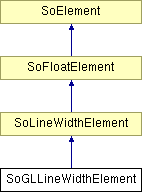
#include <Inventor/elements/SoGLLineWidthElement.h>
Inheritance diagram for SoGLLineWidthElement::

Public Methods | |
| virtual void | init (SoState *state) |
| virtual void | push (SoState *state) |
| virtual void | pop (SoState *state, const SoElement *prevTopElement) |
| virtual void | lazyEvaluate (void) const |
| virtual SbBool | isLazy (void) const |
Static Public Methods | |
| void | initClass (void) |
Protected Methods | |
| virtual | ~SoGLLineWidthElement () |
| virtual void | setElt (float width) |
Requests from the scenegraph to change the linewidth when rendering OpenGL line primitives will be made through this element, which forwards it to the appropriate native OpenGL call.
The Coin library does not place any bounds on the values of the linewidths, but be aware that the range and granularity of what is valid linewidths depends on the underlying OpenGL implementation. Application programmers using line primitives (typically through the SoLineSet or SoIndexedLineSet nodes) should heed these boundary values. They can be acquired by running the following code from within a valid OpenGL context:
GLfloat bounds[2];
glGetFloatv(GL_LINE_WIDTH_RANGE, bounds);
GLfloat granularity[1];
glGetFloatv(GL_LINE_WIDTH_GRANULARITY, granularity);Another, perhaps more convenient, way of acquiring the OpenGL implementation limits with regard to pointsizes is to use the So*GLWidget::getPointSizeLimits() method in the GUI "glue" interface library you are using (SoQt, SoXt, SoGtk, SoWin, ...).
|
|
Destructor. |
|
|
Initialize relevant common data for all instances, like the type system. Reimplemented from SoLineWidthElement. |
|
|
This function initializes the element type in the given SoState. It is called for the first element of each enabled element type in SoState objects. Reimplemented from SoLineWidthElement. |
|
|
This method is called every time a new element is required in one of the stacks. This happens when a writable element is requested, using SoState::getElement() or indirectly SoElement::getElement(), and the depth of the current element is less than the state depth. Overload this method if your element needs to copy data from the previous top of stack. The push() method is called on the new element, and the previous element can be found using SoElement::getNextInStack(). Reimplemented from SoElement. |
|
|||||||||||||||
|
This method is callled when the state is popped, and the depth of the element is bigger than the current state depth. pop() is called on the new top of stack, and a pointer to the previous top of stack is passed in prevTopElement. Overload this method if you need to copy some state information from the previous top of stack. Reimplemented from SoElement. |
|
|
Evaluates lazy element. This will finally push the element value to the rendering state.
Reimplemented from SoElement. |
|
|
Returns Lazy evaluation (of for instance OpenGL calls) is done as an important optimization measure. State-changes are usually expensive when rendering is done at least partially through hardware acceleration features. We avoid doing as much unnecessary state changes as possible by only setting the correct state right before it is actually needed. Reimplemented from SoElement. |
|
|
Set element value. Reimplemented from SoFloatElement. |
 1.2.9 written by Dimitri van Heesch,
© 1997-2001
1.2.9 written by Dimitri van Heesch,
© 1997-2001